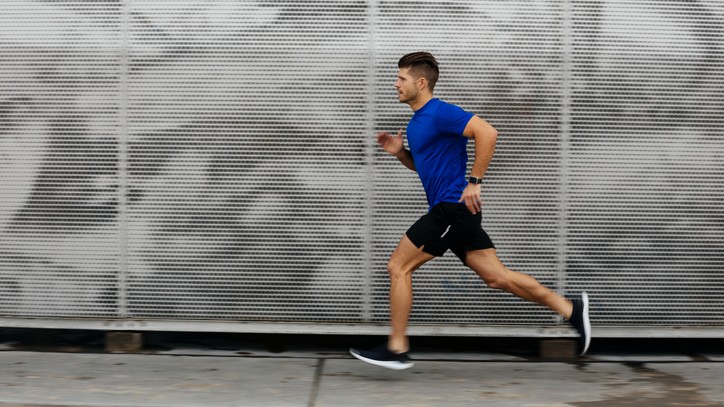Is running cardio?
Is running cardio? If you've ever wondered whether your daily habit of pounding the pavement counts as cardio exercise, we've asked the experts to weigh in

It can certainly feel like your heart might beat out of your chest during a session, but is running cardio exercise? We know it's important to aim for a range of cardio, strength, and flexibility exercises across an average week, but sometimes it's hard to know which sports and activities fall into which category.
Around 50 million Americans are fans of running, jogging or run-walking, and if you're aiming to up your cardio, we've got good news: running is a fantastic form of cardio exercise. Not only that, it’s one of the best cardio exercises you can do when it comes to lowering your risk of cardiovascular disease, improving your quality of sleeping and boosting your cognitive function.
Alongside the many benefits of running, it’s also a relatively inexpensive way to get your daily dose of exercise in. While you can certainly invest in one of the best treadmills and a pair of the best running headphones so that you can workout in comfort, as long as you’ve got a decent pair of sneakers, you can lace up and get running anytime, anywhere.
What is cardio exercise?
"What sets cardio apart from other forms of exercise is the reliance on your body's ability to use oxygen during a workout," explains Jack McNamara, a strength coach and lecturer in clinical exercise physiology. "This use of oxygen, otherwise called aerobic metabolism, helps our body extract energy in the form of adenosine triphosphate (ATP) from amino acids, carbohydrates and fatty acids to fuel our muscles, usually for more prolonged activities. This is why you'll often hear cardio referred to as aerobic exercise — meaning with oxygen.
"The American College of Sports Medicine (ACSM) defines aerobic exercise as 'any activity that uses large muscle groups, can be maintained continuously and is rhythmic in nature'. So technically, all sorts of physical activities count as aerobic exercise, regardless of intensity: cycling, dancing, hiking, swimming and even walking."

Jack McNamara is a highly experienced strength coach and lecturer in clinical exercise physiology. Since starting his career in 2005, McNamara has coached numerous athletes, worked as a clinical exercise physiologist and taught degree-level exercise science courses. His extensive expertise was recognised last year when he became the first person to be awarded Master Trainer (Europe) and Chartered Practitioner (UK) status.
Most experts agree that for the maximum benefits of cardio you should aim to move at a moderate intensity or higher — you can gauge whether or not you've hit a 'moderate' intensity by being able to talk but not sing as you exercise.
The benefits of cardio exercise include improving heart health, helping to prevent or manage cardiovascular disease, cancer and diabetes, and reducing symptoms of mental health issues like depression and anxiety — plus, the runner's high sure is hard to beat!
Get the world’s most fascinating discoveries delivered straight to your inbox.

Is running cardio?
Yes, running definitely counts as cardio exercise.
"Not only does running use large muscle groups continuously and rhythmically, but it also makes our heart work harder and requires us to use more oxygen to sustain it," says McNamara.
"Unless working at very high intensities, such as sprinting, running will usually challenge our heart and lungs more than, or at least as much as, it challenges our muscles — at least at the start of a run!"
How to improve cardio fitness
Working on your technique is one of the best ways to make yourself work harder and more safely during a run.
"For most of us, running is something we have 'just done' since we were children, so we don't actively pay attention to our posture, technique or running rhythm," says McNamara.
"By shortening our stride and increasing our cadence — the total number of steps taken every minute — we can benefit not only from improved cardiovascular fitness but a reduced risk of injury and a more efficient running technique leading to improved performance."
- Read more: Expert running tips from a sports scientist

Sprinting and anaerobic exercise
You can add in some short, fast-paced exercises such as sprints to get in some anaerobic exercise.
"Anaerobic exercise is a physical activity that causes the body to break down glucose for energy without oxygen," says McNamara. "This usually happens within the body when oxygen demand surpasses the supply. Generally, these activities are of short length with high intensity."
It can be a great way to make your running work towards strengthening your bones, as well as increasing your lactic threshold (allowing you to work harder for longer) and improving general power.
To increase the intensity of your workouts, McNamara recommends:
- Increasing the number of sprint intervals
- Shortening the active recovery/rest periods
- Increasing the duration of the hard part of your intervals
- Changing your terrain or adding inclines
- Increasing your speed
Lizzy Dening is a freelance journalist, based in Peterborough, UK. She specialises in health and fitness content, as well as women's rights (particularly around sexual violence). She's previously been published in titles including The Guardian, Elle, Vogue, Marie Claire, Grazia, Women's Health, and the Independent.
She also writes a free monthly newsletter called Out Of Office, on Substack, which is aimed at self-employed women. She's an enthusiastic if often-injured runner, a sporadic poet and is interested in just about every new fitness trend going. Find her on Twitter @lizzydening

